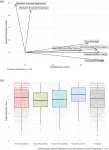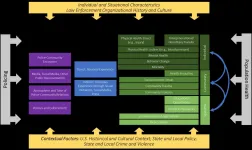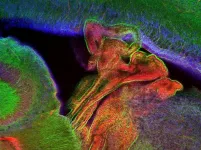INFORMATION:
Scientists solve 40-year mystery over Jupiter's X-ray aurora
A research team co-led by UCL has solved a decades-old mystery as to how Jupiter produces a spectacular burst of X-rays every few minutes.
2021-07-09
(Press-News.org) A research team co-led by UCL (University College London) has solved a decades-old mystery as to how Jupiter produces a spectacular burst of X-rays every few minutes.
The X-rays are part of Jupiter's aurora - bursts of visible and invisible light that occur when charged particles interact with the planet's atmosphere. A similar phenomenon occurs on Earth, creating the northern lights, but Jupiter's is much more powerful, releasing hundreds of gigawatts of energy, enough to briefly power all of human civilisation*.
In a new study, published in Science Advances, researchers combined close-up observations of Jupiter's environment by NASA's satellite Juno, which is currently orbiting the planet, with simultaneous X-ray measurements from the European Space Agency's XMM-Newton observatory (which is in Earth's own orbit).
The research team, led by UCL and the Chinese Academy of Sciences, discovered that X-ray flares were triggered by periodic vibrations of Jupiter's magnetic field lines. These vibrations create waves of plasma (ionised gas) that send heavy ion particles "surfing" along magnetic field lines until they smash into the planet's atmosphere, releasing energy in the form of X-rays.
Co-lead author Dr William Dunn (UCL Mullard Space Science Laboratory) said: "We have seen Jupiter producing X-ray aurora for four decades, but we didn't know how this happened. We only knew they were produced when ions crashed into the planet's atmosphere.
"Now we know these ions are transported by plasma waves - an explanation that has not been proposed before, even though a similar process produces Earth's own aurora. It could, therefore, be a universal phenomenon, present across many different environments in space."
X-ray auroras occur at Jupiter's north and south poles, often with clockwork regularity - during this observation Jupiter was producing bursts of X-rays every 27 minutes.
The charged ion particles that hit the atmosphere originate from volcanic gas pouring into space from giant volcanoes on Jupiter's moon, Io.
This gas becomes ionised (its atoms are stripped free of electrons) due to collisions in Jupiter's immediate environment, forming a donut of plasma that encircles the planet.
Co-lead author Dr Zhonghua Yao (Chinese Academy of Sciences, Beijing) said: "Now we have identified this fundamental process, there is a wealth of possibilities for where it could be studied next. Similar processes likely occur around Saturn, Uranus, Neptune and probably exoplanets as well, with different kinds of charged particles 'surfing' the waves."
Co-author Professor Graziella Branduardi-Raymont (UCL Mullard Space Science Laboratory) said: "X-rays are typically produced by extremely powerful and violent phenomena such as black holes and neutron stars, so it seems strange that mere planets produce them too.
"We can never visit black holes, as they are beyond space travel, but Jupiter is on our doorstep. With the arrival of the satellite Juno into Jupiter's orbit, astronomers now have a fantastic opportunity to study an environment that produces X-rays up close."
For the new study, researchers analysed observations of Jupiter and its surrounding environment carried out continuously over a 26-hour period by the Juno and XMM-Newton satellites.
They found a clear correlation between waves in the plasma detected by Juno and X-ray auroral flares at Jupiter's north pole recorded by X-MM Newton. They then used computer modelling to confirm that the waves would drive the heavy particles towards Jupiter's atmosphere.
Why the magnetic field lines vibrate periodically is unclear, but the vibration may result from interactions with the solar wind or from high-speed plasma flows within Jupiter's magnetosphere.
Jupiter's magnetic field is extremely strong - about 20,000 times as strong as Earth's - and therefore its magnetosphere, the area controlled by this magnetic field, is extremely large. If it was visible in the night sky, it would cover a region several times the size of our moon.
The work was supported by the Chinese Academy of Sciences, the National Natural Science Foundation of China, and the UK's Science and Technology Facilities Council (STFC), Royal Society, and Natural Environment Research Council, as well as ESA and NASA.
* Jupiter's X-ray aurora alone releases about a gigawatt, equivalent to what one power station might produce over a period of days.
ELSE PRESS RELEASES FROM THIS DATE:
Elevated warming, ozone have detrimental effects on plant roots, promote soil carbon loss
2021-07-09
Two factors that play a key role in climate change - increased climate warming and elevated ozone levels - appear to have detrimental effects on soybean plant roots, their relationship with symbiotic microorganisms in the soil and the ways the plants sequester carbon.
The results, published in the July 9 edition of Science Advances, show few changes to the plant shoots aboveground but some distressing results underground, including an increased inability to hold carbon that instead gets released into the atmosphere as a greenhouse gas.
North Carolina State University researchers examined the interplay of warming and increased ozone levels with certain important underground organisms - arbuscular ...
COVID-19 pandemic linked to reduced access to gender-affirming care in 76 countries
2021-07-09
A survey offered to transgender and nonbinary people across six continents and in thirteen languages shows that during the first months of the COVID-19 pandemic, many faced reduced access to gender-affirming resources, and this reduction was linked to poorer mental health. Brooke Jarrett of the Johns Hopkins Bloomberg School of Public Health, Baltimore, Maryland, and colleagues present the findings in the open-access journal PLOS ONE on July 9.
Gender-affirming resources, which can include health care such as surgery and/or hormone therapy as well as gender affirming services and products --are well-known to significantly ...
The role of race and scientific trust on support for COVID-19 social distancing
2021-07-09
Trust in science - but not trust in politicians or the media - significantly raises support across US racial groups for COVID-19 social distancing.
INFORMATION:
Article Title: The role of race and scientific trust on support for COVID-19 social distancing measures in the United States
Funding: The authors received no specific funding for this work.
Competing Interests: The authors have declared that no competing interests exist.
Article URL: https://journals.plos.org/plosone/article?id=10.1371/journal.pone.0254127
...
Study model explores impact of police action on population health
2021-07-09
A specific police action, an arrest or a shooting, has an immediate and direct effect on the individuals involved, but how far and wide do the reverberations of that action spread through the community? What are the health consequences for a specific, though not necessarily geographically defined, population?
The authors of a new UW-led study looking into these questions write that because law enforcement directly interacts with a large number of people, "policing may be a conspicuous yet not-well understood driver of population health."
Understanding how law enforcement impacts the mental, physical, social and structural health and wellbeing of a community is a complex challenge, involving many academic and research ...
Neonatal meningitis: the immaturity of microbiota and epithelial barriers implicated
2021-07-09
Meningitis is associated with high mortality and frequently causes severe sequelae. Newborn infants are particularly susceptible to this type of infection; they develop meningitis 30 times more often than the general population. Group B streptococcus (GBS) bacteria are the most common cause of neonatal meningitis, but they are rarely responsible for disease in adults. Scientists from the Institut Pasteur, in collaboration with Inserm, Université de Paris and Necker-Enfants Malades Hospital (AP-HP), set out to explain neonatal susceptibility to GBS meningitis. In a mouse model, they demonstrated that the immaturity of both the gut microbiota and epithelial barriers such as the gut and choroid plexus play a role in the susceptibility of newborn infants to bacterial meningitis caused by ...
Sensitivity of the Delta variant to sera from convalescent and vaccinated individuals
2021-07-09
The Delta variant was detected for the first time in India in October 2020 and has since spread throughout the world. It is now dominant in many countries and regions (India, the UK, Portugal, Russia, etc.) and is predicted to be the most prevalent variant in Europe within weeks or months. Epidemiological studies have shown that the Delta variant is more transmissible than other variants. Scientists from the Institut Pasteur (CNRS joint unit), in collaboration with Hôpital Européen Georges Pompidou (part of the Paris Public Hospital Network or AP-HP), Orléans Regional Hospital and Strasbourg University Hospital, studied the sensitivity of the Delta variant ...
Dying cells protect their neighbors to maintain tissue integrity
2021-07-09
To enable tissue renewal, human tissues constantly eliminate millions of cells, without jeopardizing tissue integrity, form and connectivity. The mechanisms involved in maintaining this integrity remain unknown. Scientists from the Institut Pasteur and the CNRS today revealed a new process which allows eliminated cells to temporarily protect their neighbors from cell death, thereby maintaining tissue integrity. This protective mechanism is vital, and if disrupted can lead to a temporary loss of connectivity. The scientists observed that when the mechanism is deactivated, the simultaneous elimination of ...
Huge volcanic eruption disrupted climate but not human evolution
2021-07-09
New Brunswick, N.J. (July 9, 2021) -- A massive volcanic eruption in Indonesia about 74,000 years ago likely caused severe climate disruption in many areas of the globe, but early human populations were sheltered from the worst effects, according to a Rutgers-led study.
The findings appear in the journal PNAS.
The eruption of the Toba volcano was the largest volcanic eruption in the past two million years, but its impacts on climate and human evolution have been unclear. Resolving this debate is important for understanding environmental changes during a key interval in human evolution.
"We were able to use a large number of climate model simulations to resolve what seemed like a paradox," said lead author Benjamin Black, an assistant professor in the Department ...
New 3D printable phase-changing composites can regulate temperatures inside buildings
2021-07-09
Changing climate patterns have left millions of people vulnerable to weather extremes. As temperature fluctuations become more commonplace around the world, conventional power-guzzling cooling and heating systems need a more innovative, energy-efficient alternative, and in turn, lessen the burden on already struggling power grids.
In a new study, researchers at Texas A&M University have created novel 3D printable phase-change material (PCM) composites that can regulate ambient temperatures inside buildings using a simpler and cost-effective manufacturing process. Furthermore, these composites can be added to building materials, like paint, or 3D printed as decorative home accents to seamlessly integrate into different indoor environments.
"The ability to integrate phase-change materials ...
Combining gamification, cash incentive increases veterans' exercise
2021-07-09
We know that turning goals into a game can increase people's physical activity. We also know that financial incentives can be effective, especially when they're framed in a way where people lose money if they don't reach their goals. But a new Perelman School of Medicine at the University of Pennsylvania study adds to evidence that combining the two can result in significant gains.
Researchers affiliated with Penn Medicine's Center for Health Care Innovation showed that a group of veterans who were overweight or obese and receiving care from a Philadelphia hospital were able to increase their daily step counts by more than 1,200, on average, when their personalized goals were paired with a game in which they received support from a buddy, all while they stood ...
LAST 30 PRESS RELEASES:
Review article | Towards a Global Ground-Based Earth Observatory (GGBEO): Leveraging existing systems and networks
Penn and UMich create world’s smallest programmable, autonomous robots
Cleveland researchers launch first major study to address ‘hidden performance killer’ in athletes
To connect across politics, try saying what you oppose
Modulating key interaction prevents virus from entering cells
Project explores barriers to NHS career progression facing international medical graduates
Jeonbuk National University researchers explore the impact of different seasonings on the flavor perception of Doenjang soup
Two Keck Medicine of USC Hospitals named Leapfrog Top Teaching Hospitals
World-first discovery uncovers how glioblastoma tumours dodge chemotherapy, potentially opening the door to new treatments
A fatal mix-up: How certain gut bacteria drive multiple sclerosis
New AI tool identifies not just genetic mutations, but the diseases they may cause
Deep-learning model predicts how fruit flies form, cell by cell
Combination pills for high blood pressure may simplify treatment, improve long-term health
Immune system keeps mucosal fungi in check
Neurons within the brain use simple rules to localize genetic messages
Electrodes created using light
Second-hand gift-giving is a well-deliberated decision
How human interaction drove evolution to make bears less aggressive
National Poll: Few parents offer teens guidance on healthy eating during holiday season
Cannabis derivatives could provide new ovarian cancer treatments
Raising strong yeast as a petroleum substitute
Clues to the origin of hot Jupiters hidden in their orbits
Canada’s reduced pledge to Global Fund will impact domestic health
1 in 4 children with major traumatic injuries not cared for in pediatric trauma centres
Duke and Duke-NUS’ joint cross-population research to uncover "East-West" differences in disease and care
Scientists to ‘spy’ on cancer- immune cell interactions using quantum technology breakthrough
Tech savvy users have most digital concerns
Making lighter work of calculating fluid and heat flow
Normalizing blood sugar can halve heart attack risk
Lowering blood sugar cuts heart attack risk in people with prediabetes
[Press-News.org] Scientists solve 40-year mystery over Jupiter's X-ray auroraA research team co-led by UCL has solved a decades-old mystery as to how Jupiter produces a spectacular burst of X-rays every few minutes.





